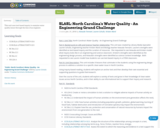
This unit uses text-based inquiry to examine water quality issues through the lens of an engineer.
- Subject:
- Applied Science
- Career and Technical Education
- Material Type:
- Unit of Study
- Date Added:
- 09/18/2017

This unit uses text-based inquiry to examine water quality issues through the lens of an engineer.
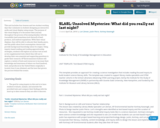
This unit includes four lessons and two student working days that culminate in students designing an interactive audio and visual display using emaze. The purpose of this visual display is to document their journey throughout the process of becoming familiar with the traceability (and sometimes lack thereof) of beef, produce, and seafood regulations. With their visual displays, they will be able to educate their family, peers, and the public about food consumption choices and provide background knowledge about its origins.
Using inquiry-based reading and reading apprenticeship strategies, students will explore an anchor text as well as two supplemental texts which they will use to develop their own essential and supporting questions to guide their research. AP Environmental students will explore a variety of texts and resources to increase their knowledge and awareness of where our food (seafood, beef, and produce) in the United States originally is located, how it was obtained, and the laws that govern the process behind the scenes.
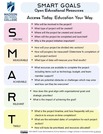
This SMART Goals Worksheet is designed to help educators develop clear, actionable, and achievable objectives using the SMART criteria. SMART goals are Specific, Measurable, Achievable, Relevant, and Time-bound. By applying these criteria, users can create well-defined goals that are easier to track and achieve.

The University of Lethbridge Teaching Centre in a conversation with Chemistry professor Dr. Ying Zheng and her student assistant Keith Aiken on their OER textbook creation for the Chemistry of the Life Sciences II.

This guidebook was created by ISKME, in partnership with the Science Education Resource Center (SERC) at Carleton College. The document provides a practical reference for curators and authors of STEM OER, and contains 23 accessibility criteria, or elements, to reference as they curate, design and adapt materials to be accessible for STEM learners.
The primary audience of this resource is STEM postsecondary faculty, instructional designers, and others responsible for course design and pedagogy who seek to:
- Expand their knowledge about accessibility and ways to integrate it into their STEM curriculum and instruction
- Design openly licensed STEM courses and course materials that support both access and use by learners
- Curate existing STEM content that expands upon traditional textbooks and courseware to address variability in learning
- Identify and add meaningful keywords, or tags, to the STEM OER they create, so that their OER can be more easily discovered across platforms
Professional learning teams on campus are also encouraged to use this framework as part of training to facilitate integration of accessibility concepts into STEM course design and pedagogy.
The framework and guide development was supported by a mini-grant program facilitated by Bates College and the SCORE-UBE Network (Sustainability Challenges for Open Resources to promote an Equitable Undergraduate Biology Education), with funding from The William and Flora Hewlett Foundation. The framework and guide were developed by ISKME and SERC with input from 21 STEM faculty members from across the United States, and in collaboration with the project’s Working Group of accessibility experts: Andrew Hasley and Hayley Orndorf, both with BioQUEST’s UDL Initiative and the Quantitative Undergraduate Biology Education and Synthesis (QUBES) Project; Hannah Davidson, Plymouth State University; and Cynthia Curry, National Center on Accessible Educational Materials (AEM)/CAST.
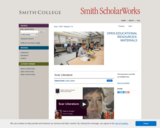
This video lecture tells the story of “Scar Literature,” a gut-wrenching literary movement that bravely confronted the wounds of China’s Cultural Revolution. Dozens of evocative images illustrate the movement’s significance, its key stories and their historical contexts. The video invites viewers to consider Scar Literature’s legacy for healing trauma in China and beyond.
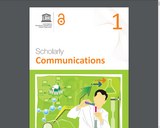
Researchers, scholars and scientists main business is scholarly communication. We communicate about our work to others, as we push the boundaries of what we know and the society knows. We question established notions and truths about science. We share our findings with others, and in a way that is popularly known as scholarly communication which emerged with the publication of first journal in 1665. However, the term gained popularity only in the 1970s, as access to peer reviewed and scholarly communication became difficult. This module has four units covering introduction to scholarly communication, peer reviewed journals, electronica journals and databases and the Serials Crisis. At the end of this module, the learner is expected to be able to:
- Explain philosophy, mission, and objectives of scholarly communication
- Describe the process of scholarly communication
- Identify different channels of scholarly communication
- Discuss the dysfunctioning of the scholarly communication
In Unit 1, Introduction to scholarly communication, we have discussed different aspects of scholarly communication – particularly its genesis, importance and ethics of academic publishing, and different communication channels available in academic publishing. Some of these channels are commonly described as primary sources as they provide first-hand testimony or direct evidence concerning a topic under investigation. Historically, scientific journals were initiated by learned societies and other scholarly communities for reporting results of concluded research works or scientific discoveries. Now many forprofit publishers have started publishing research journals.
Unit 2, Communicating with Peer Review Journals, covers two important academic publishing channels, namely peer reviewed journals, conferences and their proceedings. This Unit also highlights different methods and procedures of peer reviewing for publishing primary literature emanated from research studies. The peer reviewing is essential for validating quality of research findings conveyed by researchers, which are subject to fulfilment of ethical standards and appropriate research design, sampling and other methodological issues.
In Unit 3, Electronic journals and databases, we have discussed the emergence of electronic journals in academic and research environment due to wide proliferation of information and communication technologies (ICT) in research communications and academic publishing. Scientific communities and scientific communications from the global South are getting substantive attentions through adaptation of electronic journals and electronic academic databases in the process of research communications.
In Unit 4, the Serials Crisis, we discuss the cost of peer reviewed publications and the problems faced by researchers in developing countries. The focus of this unit is on highlighting the problems and discusses possible solutions including the emergence of open access as one of the solutions. Open access journal publishing helps in mitigating some of the problems associated with serials crisis.
This is Module One of the UNESCO's Open Access Curriculum for Researchers.
Full-Text is available at http://unesdoc.unesco.org/images/0023/002319/231938e.pdf

Personal choice and voice are key components to successful face-to-face and virtual learning for today’s K-12 students. Open Educational Resources can support these strategies of inquiry and personalized learning in many formats. Through the readings, digital tool exploration, and OER creation activity in this module, school librarians will further develop their digital expertise in creating student-centered (voice and choice) curriculum and instruction.By publishing lessons on OER Commons, other educators can find them, revise them and reshare them, thus expanding and improving access for all! This is a renewable assignment for school librarians – remember, renewable assignments are an alternative to traditional, disposable assignments, which students “throw away” after they are graded. With renewable assignments learners are asked to create and openly license valuable artifacts that, in addition to supporting their own learning, will be useful to other learners both inside and outside the classroom. An essential part of renewable assignments is the capacity to share them publicly and with an open license. As a school librarian, the lesson you create can also be a renewable assignment designed for K-12 learners; there are samples of renewable assignments in the folder Sample Renewable Assignments in the Renewable Assignments group.
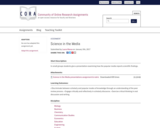
In small groups students give a presentation examining how the popular media reports scientific findings.

This resource is about finding and recognizing OER. How to search for Open Educational Resources (OER)?Which material to use for my OER?How to attribute open material using the TASLL rule?Except where otherwise noted, this work is licensed under CC BY 4.0 (https://creativecommons.org/licenses/by/4.0/) by ZHAW, University Library (17 October 2022).
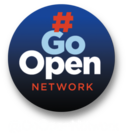
On Tuesday, February 14, 2023, #GoOpen held a public webinar titled, "Share the Love: OER and Peer Mentoring." This session featured Gina Loveless, Educational Technology Consultant with the Michigan Department of Education, and Yvette McMahon-Arnold, Director of Instructional Development, State Office of Curriculum & Instruction, at the Virgin Islands Department of Education, in conversation about how their collaboration offers high-value supports to their ongoing development of OER strategies and implementation.
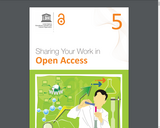
This is the last Module of the course on Open Access for researchers. So far you have studied about Open Access, its history, advantages, initiatives, copyrights and licensing, evaluation matrix for research – all in the context of scholarly communication. In this Module with just two units, we would like to help you share your work in Open Access though repositories and journals. At the end of this module, you are expected to be able to:
- Understand the publication process involved in dissemination of scholarly works;
- Choose appropriate Open Access journals and repositories for sharing research results;
- Use social media to promote personal research work and build reputation.
In Unit 1, we discuss the research publication process at five stages – planning stage, preparing stage, pre-publication stage, publication stage and postpublication stage. We emphasize the importance of social media in sharing and making your work visible to the target groups.
In Unit 2, we focus on sharing your research through OA repositories and Journals. First we discussed the different types of repositories to select and highlighted the steps that you may consider including deposit in your own institutional repositories or in global open repositories. We then discuss the sources of finding and deciding on OA journals. This unit also provides guidance on choosing the right OA journals, as the quality of OA journals is often questioned.
This is Module Five of the UNESCO's Open Access Curriculum for Researchers.
Full-Text is available at http://unesdoc.unesco.org/images/0023/002322/232211E.pdf
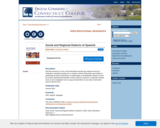
An advanced undergraduate-level course.
This book presents an intermediate-advanced level course that employs preexisting resources and materials created by the author, Dr. Emily Kuder, to facilitate the learning of topics related to hispanic dialectology and sociolinguistics through openly available content. The book can be used by learners as a self-guided course or by a group of learners in a conventional class as a textbook.
Chapter 1: La sociolingüística del español
Chapter 2: El contacto lingüístico
Chapter 3: El cambio lingüístico

Course: Spatial ETL and FME® safe software Inc Intended for: Students, Data analyst, planners, decision makers, business intelligence.
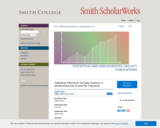
Help! I’m completely new to coding and I need to learn R and RStudio! What do I do?
If you’re asking yourself this question, then you’ve come to the right place! Start with the “Introduction for students” section.
Are you an instructor hoping to use this book in your courses? We recommend reading the “Introduction for students” section first. Then, read the “Introduction for instructors” section for more information on how to teach with this book.
Are you looking to connect with and contribute to ModernDive? Then, read the “Connect and contribute” section for information on how.
Are you curious about the publishing of this book? Then, read the “About this book” section for more information on the open-source technology, in particular R Markdown and the bookdown package.
This record and link is to the website for the book: Statistical Inference via Data Science: A ModernDive into R and the Tidyverse!
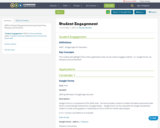
OER for Student Engagement featuring Google Form, Nearpod, and PearDeck
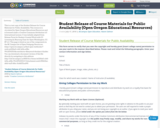
This is a text copy of the Student Release for Course Materials for Public Availability. This resource is circulated by Open Oregon Educational Resources and is licensed under a Creative Commons Attribution 4.0 International License. It was initially adapted from Release Form for Student-Created Work with CC Licensing by Boyoung Chae for Open Washington, CC-BY 4.0.
This page is listed as one of the components in the BC Campus list of Open Pedagogy Resources: https://open.bccampus.ca/find-open-textbooks/?uuid=a432f4e0-c66f-465a-a08e-99c207415111&contributor=&keyword=&subject=Guides
You can download a document version of this file directly by navigating to this address: http://solr.bccampus.ca:8001/bcc/items/a432f4e0-c66f-465a-a08e-99c207415111/1/?attachment.uuid=05f423ee-d6b3-4a7f-8f6c-5c8d072ca095
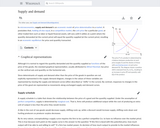
In microeconomics, supply and demand is an economic model of price determination in a market. It postulates that, holding all else equal, in a competitive market, the unit price for a particular good, or other traded item such as labor or liquid financial assets, will vary until it settles at a point where the quantity demanded (at the current price) will equal the quantity supplied (at the current price), resulting in an economic equilibrium for price and quantity transacted.
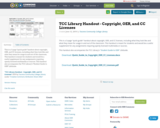
This is a 3-page "quick guide" handout about copyright, OER, and CC licenses, including what they look like and what they mean for usage in and out of the classroom. This handout is meant for students and would be a useful supplement for any assignments requiring openly licensed multimedia or sources. This handout also accompanies the TCC Library's "Student Guide to OER" LibGuide.
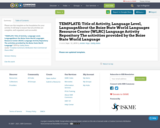
Please use this template as the foundation for your activity. It will help to ensure that all activities are complete, well organized, and successful.